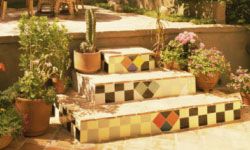Mosaic tiling remains a popular form of decoration, and has sustained its popularity through more than 2,000 years of history. At its simplest, mosaics are pieces of colorful glass, tile, ceramics and even curios, arranged in a pattern and set in plaster or cement, horizontally or vertically. The process is simple and straightforward, needing only materials, time, patience and planning.
While many companies sell mosaic tiles in a wide range of colors and textures, the simplest source is thrift shop ceramics. Browse through their selection and choose the flattest plates and servers you can in a wide variety of colors, designs and textures. Use online and book photos for inspiration.
Once the materials are sourced -- get about half as much as you think necessary -- use your hammer to break them into smaller pieces somewhere between and inch and two inches. Before smashing place the piece in a stout plastic bag to keep shrapnel at a minimum, and remember: Wear safety glasses and gloves.
Once the pieces are collected and smashed to size, bring them out to the patio and the space where you want to create the mosaic. First, do a dry layout until the design is to your liking, and then snap a photo for future reference.
Pour out your concrete and let it set until it's a little thick (but not dry). Set your mosaic pieces in the concrete, trying to keep everything as level as possible.
If your mosaic is larger than you can comfortably reach across, it may be worth your time to make it in sections. If you used a mold for concrete pavers, simply make more pavers at your leisure, each bearing a part of the design. When they're in place, set the pavers in the patio.


